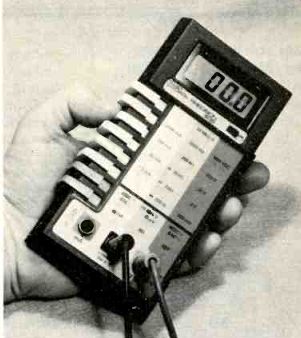Each report about an item of electronic test equipment is based on examination and operation of the device in the ELECTRONIC SERVICING laboratory. Personal observations about the performance, and details of new and useful features are spotlighted along with tips about using the equipment for best results.
By Carl Babcoke, CET

Figure 1---Data Precision model 936 has all customary 3 1/2-digit DMM features
in addition to beep tones indicating the start of continuity and continuous
sounds for overvoltages.
Data Precision 936
DMM Model 936 from Data Precision is the first digital multimeter having an audible indication (beep tone) to be examined in the Electronic Servicing lab. The model 936 is a hand-held, five-function plus beep, 29-range digital multimeter (Figure 1).
Readout and switches
All numerical measurements are displayed on 3 1/2-digit LCD digital 7-segment readout.
Six white pushbuttons on the left edge can be pushed to select any range. When one of the white buttons is pressed, the other five are unlatched and move to the outer position. Only one can remain at the on position. Two gray pushbuttons select the function (ac or dc volts, ac or dc current, or resistance). Both gray buttons must be in the proper position for each function selection. For example, both buttons are in the out position for dc volts. The bottom button is to be pressed in for resistance tests, and the top button selects high-power or low-power operation. Pan el drawings of a long button (out position) and a short button (in position) help with button selection.
The gray buttons latch at the in positions, and release when pressed a second time.
One-hand operation of all eight buttons is the advantage of the does not provide perfect accuracy edge locations.
DC voltage and current
Input impedance for all five dcV ranges is 10M it, and accuracy is +-0.1% of input +1 least-significant digit). Polarity, zeroing and decimal placement are automatic.
Each range can display one less count than the rating. The 2Vdc range, for example, can display up to 1.999V before overrange occurs.
Overrange indication shows only the most-significant digit (MSD) and the decimal. Other digits are blanked out.
Four dc-current ranges cover from 1.999mA to 1999mA. They are protected by a 2A fuse. Accuracy is rated at +- (0.5% of input +1LSD).
Ac voltage and current
Ac ranges are the same as those for dc, except the highest recommended input voltage is 700V RMS. The system operates with average sensing plus calibrations for RMS reading of sine waves.
Rated accuracy for ac voltages between 50Hz and 500Hz is ±_(0.5% of input +4LSD), and the input impedance is 10M ohm in parallel with 100pF.
Lab tests of the 20V acV range showed -1dB at about 8.5kHz and-6dB at about 26kHz. Although this over the audio range, it is better than many other DMMs, and it is helpful for providing comparative readings of audio voltages.
Accuracy for ac current is +- (0.75% of input +4LSD) between 50Hz and 100Hz.
Resistance measurements
All six resistance ranges (from 200 12 to 20M it) can be switched for either high-power (2.8V for open circuit) or low-power (0.25V for open circuit) operation. Al though the instruction manual lists no figures for the 200 12 low-power function (implying that such operation is impossible) this range did operate correctly in the sample meter. The high-power 2K it range is recommended for reading the forward resistance of transistor junctions and diodes. A test diode measured 0.67K it on this range.
Accuracy is rated differently for various combinations of ranges and excitation voltages. Highest accuracy of ± (0.1% of input +1LSD) is obtained on the 2K it to 2000K s2 ranges with high power. The 20M it range is rated at *(0.3% +1LSD).
Audible tones In addition to the accurate conventional digital readouts, model 936 also has audible sounds under certain conditions.

---------- Various functions are selected by positions of two gray pushbuttons.
Panel markings show the switch status for each function.

---------- Ranges of current, resistance and voltages are printed in three
columns above the function switch instructions.
One important application of an audible indication is for resistance measurements, particularly those involving erratic or intermittent continuity. When any of the three lowest resistance ranges with high power is selected, a beep tone sounds at the start of continuity. In the sample meter, the 3500Hz tone started at maximum volume and rapidly diminished to silence in about 1/2-second.
The 200 ohm, range beeped when applied suddenly to resistances up to about 5K ohm, the 2K ohm range to about 2.5K ohm, and the 20K ohm range to about 22K ohm.
Another feature of model the tone that sounds when any input voltage exceeds the voltage range. However, the sample meter performance was not in accordance with the instruction manual description. When audio was applied to the 200mV ac range, an input of 350mV or more was required to produce a sound. The tone was continuous and had the frequency of the input signal. Similarly, about 3.6Vac was required to start the tone on the 2Vac range. Higher ranges were not tested. Line voltage applied to the 20Vac range produced a constant buzz, but no buzz was obtained on the 200Vac range.
Considerable overvoltage was required for an audible indication on dcV ranges also. For example, 46V or higher was needed to generate a tone on the 20Vdc range.
General features and comments
Data Precision model 936 DMM operates for 100 to 200 hours (depending on type of battery) on one 9V battery. Model BE9 battery eliminator is available as an option for line operation.
Model 936 appears to be rugged and well-built. It performed efficiently and accurately during these tests. The price is listed at $159.
Also see: Selecting replacement capacitors